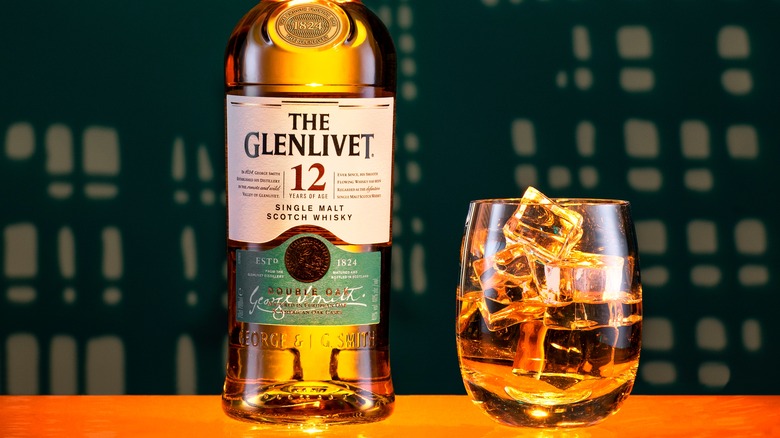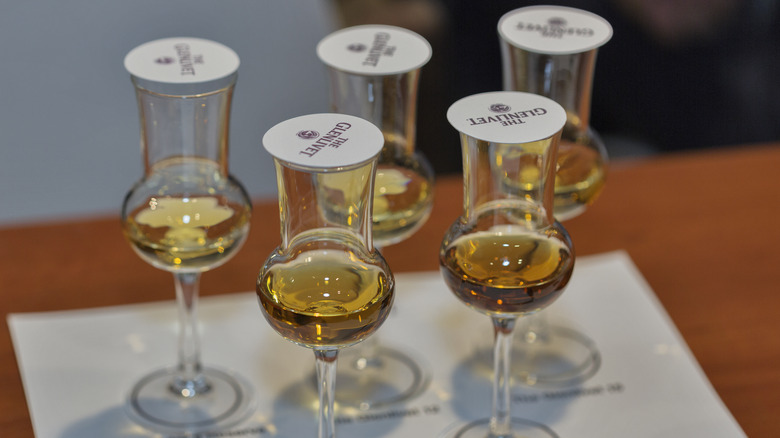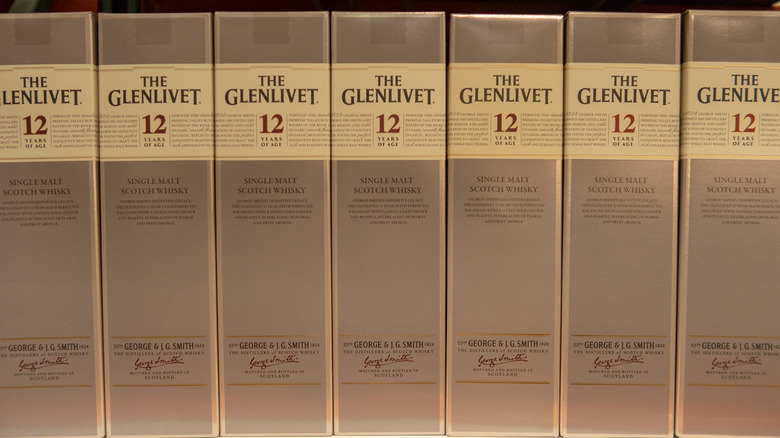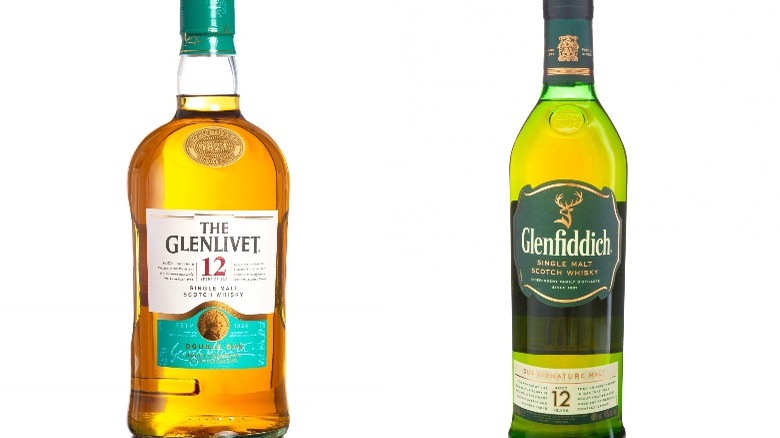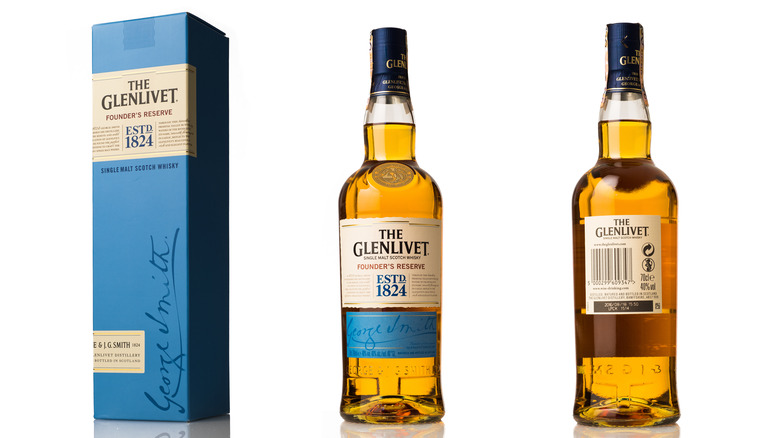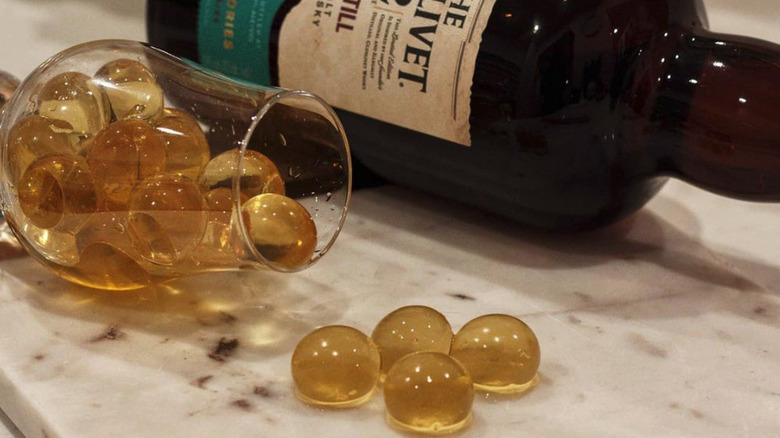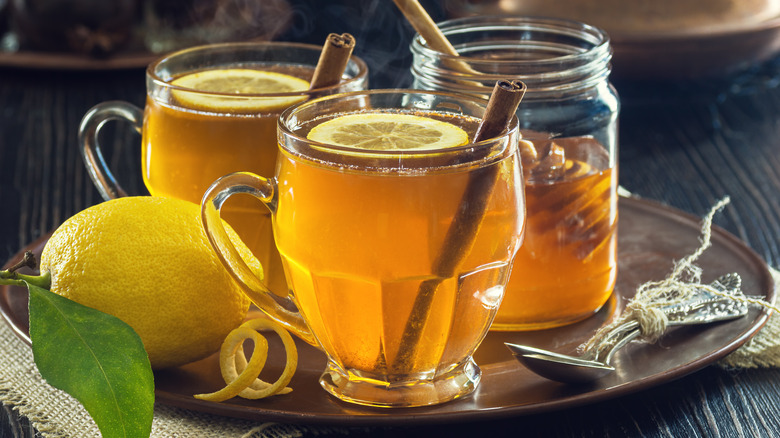The Glenlivet 12 Year Whisky: Everything You Need To Know
Even if you're new to the world of Scotch whisky, you've probably heard terms like malty and peaty being thrown around. But just like describing the many flavors of wine, it can be hard to get a handle on what those words actually mean. That's why we recommend starting with a classic dram like The Glenlivet 12 Year Whisky. According to the brand's website, the 12 Year is a 40% A.B.V. fruity, summery single malt Scotch whisky, matured in both European and American oak casks for a double-oaked finish. Sounds delicious, but what does any of it mean?
First, the single malt. According to Whiskey Watch, a single malt must meet the following criteria: aged for at least three years in oak, made with Scottish barley and water, and most importantly, it must be produced in only one single distillery. Basically, single malt equals single distillery. Scotland is famous for its delicious, pure water (there's got to be an upside to all that rain) which is perfect for making whisky.
You might also be wondering about the whiskey/whisky divide. It's not a typo, just one of those classic American/British spelling conundrums. Per Britannica, whiskey (with an "e") comes from Ireland and the United States (think Jameson and Kentucky bourbon), while no "e" whisky originates from Scotland and Canada. The important thing is that they're all distilled liquors made from fermented grains and aged in wooden casks.
Scotch has a few pretty old-fashioned connotations, but the truth is that all kinds of people drink Scotch and enjoy it. Although the industry has been mostly male-dominated, the modern Scotch whisky scene is becoming more diverse. But more on that later. For now, get comfortable and pour yourself a wee dram, because this is everything you need to know about The Glenlivet 12 Year Whisky.
The History of The Glenlivet 12 Year Whisky
According to its website, The Glenlivet is the oldest distillery in Glenlivet, a small parish in the Speyside whisky-producing region of Scotland. When George Smith began distilling whisky in the hills of the Livet valley in 1822 his operation was illegal, but when the law changed after two years Smith was first in line for a license and Glenlivet became the first legal whisky distillery in the parish.
By 1884 the reputation of the finest single malt in Scotland had spread and competitors were using the name Glenlivet to market their own whiskies. John Gordon Smith, George's youngest son and the inheritor of the distillery, made a simple change: by adding the definite article to his distillery's name, they became The Glenlivet and set themselves apart from other Speyside distilleries forever. That's no small feat, when you consider that Speyside contains more than half of all Scotland's whisky distilleries.
The Glenlivet distillery remained open through the Great Depression, and by 1933 Prohibition was over and American customers were thirsty for single malts. The Pullman Train Company began serving The Glenlivet single malt on its trips across the North American continent, and by 1950 The Glenlivet made up half of all Scotch sold in the United States–and still does today! In fact, according to the brand's current owner (since 2001), French brand Pernod Ricard, The Glenlivet is the world's second best-selling single malt whisky.
What does The Glenlivet 12 Year Whisky taste like?
As The Glenlivet website explains, each of the five whisky regions in Scotland has different characteristics when it comes to taste. The Speyside region, made up of pine forests, hidden glens, and the sparkling waters of the River Spey, tends to produce rich whiskies with notes of fruit and floral. Single malts at The Glenlivet have evolved over the years, from a robust, peaty flavor to a sweeter, lighter taste that's a bit easier on the palate.
If you're wondering what a peaty whisky might taste like, it's basically smoke: the barley that Scotch whisky is made of used to be dried over peat fires, which gives the liquor a rich, smoky flavor (per World Whisky Day). Nowadays, the use of peat is discouraged due to its contribution to greenhouse gas emissions, and Speyside whiskies have become lighter and sweeter due to this change in the distillation process.
The Glenlivet 12 Year Whisky is double oak matured in both European and American oak casks, which the brand's website explains lends the whisky delicious vanilla notes. Overall, the 12 Year Whisky is smooth and fruity, with strong notes of pineapple – which is surprisingly tropical for a drink from the cold, rainy Scottish Highlands. Enjoy the whisky with whatever food you like, of course, but the recommended food pairing is seared scallops. This food recommendation gives a big clue into the whisky's strength, as the whisky is smooth enough not to overwhelm the delicate flavor of the scallops.
How is The Glenlivet 12 Year Whisky made?
There are strict rules for what liquor can and cannot call itself Scotch. As Whiskey Watch explains, there are three steps to the process.
First, Scottish barley is harvested and soaked in the distillery's local water until it begins to germinate, which gives it a unique flavor. The Glenlivet 12 Year Whisky's water comes from Josie's Well and is rich in minerals, according to its website. The germinated barley is then dried over a fire or heat which imparts yet more flavor, like peat or heather, and the dried barley is called malt. The malt is then ground down and mixed with water to form mash, which is combined with yeast to ferment.
The resulting liquid is then distilled a number of times through copper pots and pipes, where it is heated until the liquid becomes gas and rises into another chamber. As Whisky.com notes, The Glenlivet's founder George Smith built his reputation for excellent whisky on distilling the smoothest single malts in the British Empire. This was partly down to the unique lantern-shaped pot stills, which The Glenlivet website says "adds a delicate yet complex character." The Scotch is then matured in oak casks for a minimum of three years, or in this case, for 12 years.
How to drink The Glenlivet 12 Year Whisky
Whisky is great drunk neat–that is, without a mixer and not in a cocktail. There's a whole lot of differing opinions on whether or not you should drink neat whisky with ice or water. Men with beards have debated the topic for years: ice can pick up other flavors and taint the whisky, chilling the whisky alters the flavor, water can open up the flavor or change the taste of a malt that's taken over a decade to taste a certain way and who are you to mess with years of work?
The truth is, sometimes it's lovely to have a chilled glass of whisky, but if you're drinking a classic high-level single malt Scotch whisky like The Glenlivet 12 Year, the best thing to do is have a couple of sips first to see how you like it and proceed from there. Alternatively, you can mix your lovely 12 Year Scotch into a classic cocktail, as The Glenlivet website recommends. An Old Fashioned gets a new twist (mix whisky, honey, and Angostura bitters), while a Glenlivet Royale (single malt, honey water, lemon juice and champagne) makes an excellent aperitif.
If you prefer a cocktail with a bit of bite, a Scotch Sour (made with whisky, lemon juice, simple syrup, and egg white) is delicious on a warm day, while a whisky coffee or hot toddy makes even the worst winter night bearable again.
Is The Glenlivet 12 Year Whisky expensive?
Retailing at just over $40 at Target, The Glenlivet 12 Year is nowhere near the most expensive single malt Scotches on the market. That honor goes to The Macallan Lalique 55 Year Old, which retails for nearly $200,000 according to Wine-Searcher.
In fact, the price point of The Glenlivet 12 Year makes it comparable to other hard liquors, but the unique provenance of single malt Scotch and the care and work that goes into aging it for 12 years means that you're guaranteed a taste experience that exceeds the moderate expense.
In general, the price of Scotch whisky tends to rise with age, but there are various exceptions according to the supply of each age range in the market. Curiously, on average, 10-year Scotch can be more expensive than 12-year Scotch. This is down to two reasons: firstly, the existence of pricey, rare 12-year bottles; and secondly, the fact that there is simply more 12-year Scotch available on the market than 10-year, which influences the price point.
However, if you're willing to splash out a little on a good whisky like The Glenlivet 12 Year you know you're getting a solid example of a great single malt.
The Glenlivet 12 Year Whisky vs. Glenfiddich 12 Year
These two famous whisky brands are easily confused: they both have "glen" in the name, they're both from the Speyside region of Scotland, they're both matured in European and American oak casks, and they both produce delicious single malt Scotch whisky (per the Glenfiddich website). While it's true that both whiskies have fruity notes (The Glenlivet pineapple, Glenfiddich notes of pear) and golden hues, there are several important differences between these two popular spirits.
According to Whisky & Whiskey, Glenfiddich is the best-selling single malt worldwide, while The Glenlivet is the second best-seller (as we learned above). The two 12-Year single malts are also around the same price. They're both creamy and smooth, as befits a Speyside whisky, but the Glenfiddich is a little bit sweeter, with strong floral and honey notes. However, The Glenlivet 12 Year has been called the easiest whisky to drink, especially for Scotch beginners (per Whisky & Whiskey). It's equally delicious neat, with a splash of water, or mixed into a cocktail.
The Glenlivet 12 Year vanished from shelves for several years
In 2015, the world's second best-selling single malt whisky disappeared from shelves in many countries around the world. As ScotchWhisky.com explains, dwindling stocks of the 12 year whisky forced The Glenlivet to withdraw that range from all but a few key markets, with the reduction in availability expected to last as long as five years.
Of course, with an incredibly popular drink that's aged for a 12 full years, it makes sense that it would take quite a bit of time to build stocks up again. The distillery was also undergoing a large expansion, which would allow it to increase production.
In the meantime, however, The Glenlivet introduced a no-age replacement called The Glenlivet Founder's Reserve, which turned out to be very well received by whisky lovers the world over. Conceived as an entry point whisky (much like the 12 Year Whisky), The Glenlivet Founder's Reserve sold around 280,000 cases per year — a success by any measure!
However, the 12 Year Whisky was back on shelves sooner than expected, returning to the United Kingdom two years ahead of schedule in 2018. Since then, stocks seem to have recovered, but it's always worth remembering that your favorite dram can disappear without warning. We're not saying you should always keep an extra bottle (or 12!) in the cabinet just in case, but we're not not saying that.
The Glenlivet 12 Year Whisky is sometimes available in edible form
Vegan? Gluten-free? No problem; the only requirement here is that you're not a tee-totaller, because this cocktail is one you can chew. The Glenlivet first launched its fully edible cocktail capsules in 2019, and it brought them back again in 2022.
Take a moment of silence to remember all the whisky purists who no doubt got a bee in their beards over this. Then, imagine the following: a spherical capsule covered in an edible seaweed casing through which a golden whisky gleams. The cocktail capsules were designed to be served without water or ice, or even a glass. That's right, folks, simply pop one (or more) in your mouth and enjoy an adults-only Gushers-like experience.
The cocktails were available in five flavors (or capsules to be more specific). Patrons could choose from Ool La La (The Glenlivet Founder's Reserve, vanilla syrup, peach, and oolong tea), Scottish Coffee (Founder's Reserve, coffee, and sugar), Mai Tai (The Glenlivet Caribbean Reserve, triple sec, orgeat syrup, and lime), or an Old Fashioned or Whisky Sour, both featuring The Glenlivet 12 Year Whisky.
Most people, perhaps unfairly, compared them to Tide Pods (don't eat Tide Pods please), but we think there's something delightfully Willy Wonka about the whole thing.
The best hot toddy is a hot tea toddy
Speaking of cocktails, we all know that winter is immeasurably improved by a classic hot toddy, and that Canadian winters are particularly challenging. Enter The Glenlivet 12 Year Whisky collaboration with David's Tea. As Globe NewsWire explained, in November of 2021, popular Canadian tea brand David's Tea teamed up with The Glenlivet 12 Year Whisky to create a signature cocktail: the pumpkin hot toddy. (Notice it wasn't called the pumpkin spice hot toddy.)
A mix of single malt Scotch whisky and pumpkin crème brulée tea (along with a cinnamon stick and a dash of orange bitters), the pumpkin hot toddy took the best of two iconic brands and forged them a delicious and (hopefully) long-lasting friendship.
We can only imagine how the pineapple notes of the Scotch combine with the creamy pumpkin and white chocolate of the tea to make a perfectly sweet concoction we could probably drink seven of without noticing. Move over, Starbucks pumpkin spice latte because there's a new holiday drink in town to sip on.
The Glenlivet is breaking stereotypes of Scotch drinkers
Remember what we were saying before about the stereotypical whisky drinker (aka the mythical middle-aged white man in the leather armchair?) Well, The Glenlivet's new ad campaign, starring Oscar-winning actor Anna Paquin, seeks to upend that old image.
As Campaign Brief notes, one third of whisky drinkers worldwide are women. That's a pretty big whisky-drinking market that should definitely be acknowledged! It turns out that it's all part of The Glenlivet's global mission to #breakthestereotype with their new platform titled "This is Whisky."
As well as the campaign starring Paquin, Glenlivet infiltrated search engine algorithms to change the visual landscape of what whisky drinkers look like: a user searching "whisky drinker" on Google Images will find a diverse set of real whisky drinkers. It's admirable, but it's also the latest iteration of modernity in an industry whose history features several ground-breaking women-owned distilleries.
Elizabeth Cumming inherited the Cardhu distillery in Speyside when her husband died, and despite being pregnant with her third son at the time, decided to expand it instead of selling it. After 20 years of success, during which she upped production from 20,000 to 60,000 gallons per year, she sold it in 1892 to John Walker & Sons–better known today as Johnnie Walker.
Then there was Bessie Williamson, who started at the famous Islay distillery Laphroaig as a secretary and ended up running the entire thing. Today, women are prominent at every level of the Scotch whisky business.
